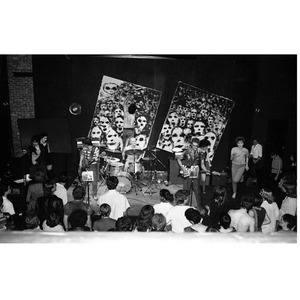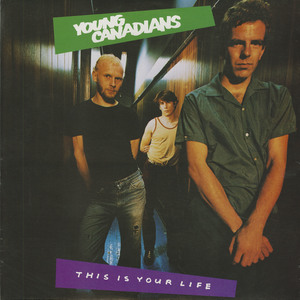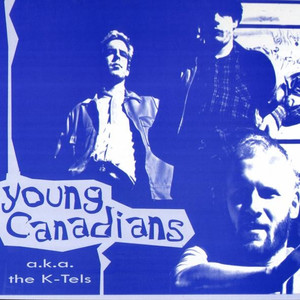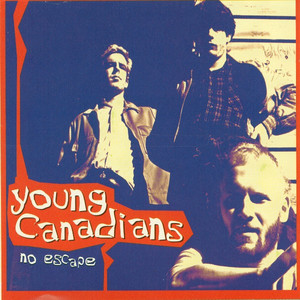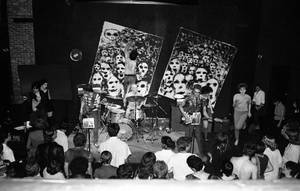Young Canadians (2)
Websites:
https://artbergmann.com/
Origin:
Vancouver, British Columbia
Biography:
The K-Tels came together out of the rubble of the Shmorgs, surely one of the worst names any drunken yahoo ever spray-painted on a wall. Fittingly, in retrospect, they were also pretty lousy, terminally infected with a sort of Asylum Records/singer-songwriter/LA/country sound that wasn’t helped by the addition of several “lead” guitarists, and by lead I mean the types who never sully themselves with actual chords and only ever have to change the skinny strings. Art Bergmann was never comfortable playing lead. Just singing was an accomplishment akin to an acrophobe going up to one of those glass-walled elevators on the outside of a hotel, although the times when the band was forced to play as a three-piece proved Art to be in every way superior to the employees.
Typically, it would take him a few years to figure it out.
Art and I became friends, then roommates, living in various soon-to-be-condemned dwellings. We liked most of the same things - an affection for the Kinks, early Who and Yardbirds, David Bowie and the Velvet Underground- and, more importantly, hated all the same ones: mid-70’s FleetwoodMac, the Eagles, the Doobie Brothers, Supertramp, Elton John, Dark Side of the Moon. By the summer of ‘77, half a dozen of us like-minded types were living in a huge hundred-year old house on the outskirts of White Rock and a friend of Art’s showed up after a trip around the world with a cassette he’d picked up in England. On it were the Sex Pistols and things were never the same.
Being a few years younger, my friends (& after Art taught me how to play guitar, my bandmates) were already listening to the Dolls, Raw Power (earlier Ig albums were out of print) & Roxy Music, and the more Art sat listening to Shake Appeal and Stranded in the Jungle with us (Dr John and the Allmans records forgotten in the corner - sniff), the less his band wanted to have anything to do with him.
We’d make many trips from our suburban outpost to downtown Vancouver to see DOA, the Subhumans, Victorian Pork, the Dishrags, and the Shades, usually missing the last bus back to the suburbs and wandering the streets with growing hangovers until the next day. Moving to town seemed a good way to avoid that. People usually lose socks or books when they move - in spring ‘78 when Art, Bill Shirt, Gord Nicholl and I moved to Vancouver en masse Art lost the Shmorgs. He says: “I told them ‘I’m going to town, you want to come?’ and they said ‘Nah, you go and have fun with your weird new friends.’ So I did.”
The rest of us had already joined a band in town, but it took Art about a year to get a group together. Little did we know he’d been writing songs all this time while sharing the house in lower East Van (where the Clash visited after their first North American show and where Art had scooped my girlfriend, who later screwed him over for another acquaintance). Despite some ugly moments, we then all moved into three identical row houses on Victoria Drive in early ‘79.
At this time, Art unveiled the K-Tels and with only a couple of gigs they were in the first rank of bands in the city, joining DOA and the Pointed Sticks. I saw them after the surprising news that Art’s new band was going to play some place called Gambado’s, an art gallery in Gastown. We all dutifully trouped down to see what the old fellow had come up with - some of us had been less than kind during his layoff - and went home chastened, tails tucked appropriately legward.
Not only had they written a set that included most of the soon-to-be-recorded Hawaii EP, but the band collectively put together a batch of covers that defined their manic virtuosity: A Question of Temperature, I Had Too Much to Dream Last Night, Palisades Park.
He’d chosen well, Arthur had; a couple of highly skilled players who never let the technical ability get in the way of amphetamine-rush tempos and feedback. Bassist Jim Bescott had the same veins-bulging, near-hemorrhagic, tomato-in-the-microwave singing-quality that Art did, despite being physically akin to Jerry Lewis circa The Geisha Boy and per gig he managed to unload more bodily sweat than a hungover Sumo. And, in those Mel Bay “Play Guitar In 3 E-Z Lessons” punk days, a bass player who could play that well and that fast using his fingers was a shocking sight.
Barry Taylor managed to combine Dimwit’s power, Chuck Biscuits’ speed, and Jughead’s post-pube kamikaze attack with old-school technique. I wouldn’t go so far as to say he was the best drummer in town, but neither would I want to say anyone was better. And most of all, they had Art, who had evidently overcome his reluctance to being lead singer and boss guitar player.
On stage, Art sounded like a man trying to hack up an entire disease, went into slack-faced catatonia one moment and had the front row fearing for their lives the next. He had taken his guitar prototypes to new territory: always the man of a million chords, Art simply, ummm, - expanded the form. Chords led into feedback squeals, then punctuated by staccato note shards, then wrenched physically back into some approximation of melody.
Like some old delta bluesman who created a new style because his Sears & Roebuck instrument was impossible to play “correctly”, Art’s ‘61 Strat had much to do with the sounds he came up with. Purchased from his older brother by dint of a summer’s worth of newspaper delivery and lawn work, it looked to be, and was, largely unplayable. Certainly no-one else could play it. When in tune, and in this case that was an almost laughable term, chords that contained many of the proper notes in one position on the neck were found to contain none at all in a different spot. Art quite casually invented new chord fingerings to accommodate the pitch and these new voicings, combined with a much-abused Ampeg head and massive Kelly-Deyong speaker-bottom, created strange and wonderful overtones, which only encouraged him to create even more arcane structures.
When “jamming”, half-assed guitarists will watch the other guitar player or bassist’s hands to pick up the chord patterns. To this day, five minutes of that with Bergmann will leave you no wiser but you will have a dandy headache.
The K-Tels opened up the Smilin’ Buddha, something I don’t think they’ve been credited with historically and should be. (And to settle an often apocryphal anecdote, I asked the late Lachman Jir, owner and proprietor of the Buddha, if it was really true he fired Jimi Hendrix in the mid-60’s. Legend had it Hendrix was playing in some soul band and incurred Lachman’s wrath for being too loud. Told to turn it down he said something like “is this quiet enough?”, unplugged his guitar and sat down for the rest of the night, Seattle being too far to walk home. “You really fired him, Lachman?” “Too bloody loud. The waitress couldn’t hear the orders.” “And he just sat there all night?” “Sat there. Drank rum and cokes.” To the day he died, Lachman had no idea why people made a fuss over this guy he turfed.)
Although by the time Hawaii was released the local press were quite beside themselves, as my Ma used to say, “Kind words don’t butter too many spuds” and to go with the per-usual threat of imminent starvation, K-Tel the corporation had successfully forced a name change, apparently afraid punk rock might tarnish the name of the Patty-Stacker and the HomeJerky Maker.
The band (now renamed the Young Canadians) seemed to be the first to do a lot of things: first to open Gambado’s and the Buddha; first to release a Quintessence 12” EP; first to perform on live radio; first on the Vancouver Show (CKVU-TV); first to get a deal to support a major act across Canada (Boomtown Rats); and one of the first to tour down to the States.
The second Quitessence EP This is Your Life was an equally good record, but without a Hawaii-type hit, sold not nearly as many. It is, to my ears though, a better record. Data Redux, the capstone for the YC’s live blitzkrieg, was finally recorded with Bob Rock’s ear for noise, studio-quality and with cello, no less. Had they stayed together for a full album (or even another EP of the unreleased material now on this compilation)…but they broke up, like all great bands.
I think the physical exhaustion of being the frontman for a trio that played so loud and so fast just wore him out. We had plenty of discussions about how shitty it is to be the guitar player, singer and songwriter in a three-piece. Within a year or so Art joined Los Popularos, reuniting with Bill, Gord, and me. Art said publicly he quit the YC’s because they didn’t hang out and smoke and drink together and we did. And that’s one of the reasons I love him.
He’s a perverse bastard - he still won’t play Hawaii live although he could probably afford a phone if he did - and after 10 years solo he’s on his third major label & still waiting for Hollywood to call. As a singer, player, and most of all as a writer, that call’s way overdue and all of us have been waiting for him to get it because he’s only a notch below Lou Reed and Neil Young, and at least the equal of later artists like Paul Westerberg or Bob Mould.
Somewhere, someone else is driving his sports car and swimming in his pool. Mind you, if Art is ever in the neighborhood, he’ll break in and drink all their beer.
-Buck Cherry, Spring ‘95
A pioneer of Vancouver's punk scene, songwriter/guitarist Bergmann has always walked on the edge and a volatile personality and drug addiction has kept him from reaping the benefits of his on-again off-again solo career.
Growing up in Surrey, Bergmann, son of Mennenite parents, would sing along to Beatles songs with a broomstick for a guitar. He joined his first band, The Schmorgs, in 1977 and with a crudely made debut LP Bergmann and others led the Vancouver punk scene into a revolution that Bergmann would soon sign-post with a number of other legendary acts.
In 1978 he joined the K-Tels who would release two EPs - 'Hawaii' (1979) and 'This Is Your Life' (1980) before a well known record label threatened copyright infringement action against them and so they became the X-Tels and finally The Young Canadians.
In 1981 he joined Los Popularos where a drug addict with some extra cash invested $10,000 in the band's recording efforts in an attempt to launder the money. When the band wasn't able to repay the man immediately he grew impatient and threatened the members with a gun. The situation rectified itself when the investor went to jail for first degree murder. However, the record was finished - a four song EP called 'Born Free'.
In 1984 came Poisoned, whose material was produced by future stars Paul Hyde & Bob Rock, and the resulting two demo tapes and a full 6 song EP 'Poisoned' brought the band to the attention of Canada. But with the rising popularity of LA hairband Poison, they dropped the name and put Bergmann in the spotlight as frontman.
The re-formatted band worked with Vancouver producer Bob Rock (Payolas, Metallica, Aerosmith) on a collection of songs. They went to Toronto on tour to work the new material. At the very moment that Duke Street's Adrian Heaps was holding a pen and record contract, the band was getting ejected from Toronto's Rivoli club for being drunk and disorderly.
The Rock album was scrapped and all the songs would be re-record with a name producer. Velvet Underground co-founder John Cale, who had produced both Patti Smith's and the Stooges' debuts was brought in to smooth out Bergmann's sound sans backing band. Bergmann hated the new version of the 'Crawl With Me' album.
Still 'Crawl With Me' would go gold (50,000) without advantage of much radio airplay.
Next, Bergmann received a 1989 Juno Award nomination for 'Most Promising Male Vocalist' based on his 'Sexual Roulette' album . His touring band, The Showdogs, featured Poisoned's Taylor Nelson Little (drums), Ray Fulber (bass), Susann Richter (keyboards) and Mick Joy (guitar).
In 1990, he made a small appearance in director Bruce McDonald's 'Highway 61'.
Despite critical acclaim and significant airplay of the single "Faithlessly Yours"., 'Art Bergmann' (produced by Chris Wardman) only managed to sell 7,500 albums and Bergmann was ditched by his label Polygram in May 1992. At issue was lack of funding to launch a national tour which Bergmann ended up not being able to do because the label offered him half of an estimated tour budget. Many trial shows cost Bergmann money out of pocket, but nevertheless, he was out pounding away, sans band, on the Lollapahoser Tour with the likes of Bootsauce, Pure and Sons Of Freedom.
In 1993 he decided to finally kick his heroin addiction and that experience translated into his 1995 album 'What Fresh Hell Is This?'. He has since maintained a live presence with a newer backing band featuring members of Stigmata and Dead Surf Kiss.
He moved to Toronto and did a series of stand-up comedy/solo performance nights at The Generator before recording an 'unplugged' best-of called 'Design Flaw' with Chris Spedding before stepping out of music for nearly two years.
With the help of Chris Houston (Forgotten Rebels) and his production company, AudioMonster.com, dusted off his first solo demos recorded between February and April of 1984 and released the ten songs as digital downloads with the title 'Vultura Freeway' in 2000.
-Joel Anderson, Gabe Sawhney and Bill Reynolds
Produced by Bob Rock, Edward Thomas and Young Canadians
Recorded in January 1980 and mixed in May 1980 at Little Mountain Studios, Vancouver, British Columbia
Mastered at The Lacquer Channel Limited
Art Bergmann: guitar, vocals
Jim Bescott: bass, vocals
Barry Taylor: drums
